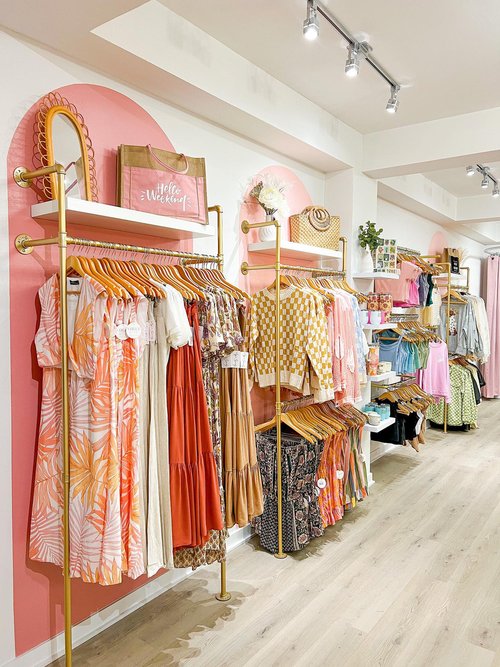Boost Your Closet with Stunning Boutique Fashion Essentials
Boost Your Closet with Stunning Boutique Fashion Essentials
Blog Article
Exploring the Development and Influence of Clothes on Modern Fashion Trends
The advancement of clothing has significantly influenced modern-day style patterns, merging historical criteria with innovative technologies. Legendary numbers like Coco Chanel and Yves Saint Laurent reinvented the fashion industry by presenting principles that prioritize convenience and access, which proceed to resonate today.
Historical Style Influencers
In the tapestry of style history, particular figures have actually left an enduring mark, shaping the fads and styles that specify whole ages. Coco Chanel, a cutting edge designer, redefined females's fashion by presenting comfortable, sophisticated clothing that left from restrictive corsets.
Elsa Schiaparelli is one more crucial figure, renowned for her progressive layouts that incorporated surrealist art, teaming up with Salvador Dalí to create wayward items that tested standard aesthetic appeals. Her cutting-edge use color and vibrant patterns resounds in contemporary fashion. Yves Saint Laurent, at the same time, democratized high fashion with prêt-à-porter collections, bringing path designs to the masses and establishing a precedent for modern ready-to-wear lines.
These enthusiasts, amongst others, not only transformed style in their times yet additionally established enduring trends that resonate in today's fashion business, giving a foundation upon which modern designers continue to introduce and construct. Their heritages underscore the importance of creativity and daring in vogue's ever-evolving narrative.
Technological Developments in Style
Among the dynamic landscape of the fashion business, technological developments stand at the forefront of development, reshaping how designers create and customers engage with fashion. The integration of 3D printing has revolutionized design procedures, making it possible for developers to experiment with complex frameworks and lasting materials that were previously inconceivable. This modern technology promotes quick prototyping, lowering waste and speeding up production times.

Smart textiles, installing technology into textiles, are also changing the sector. Developments like temperature-regulating and self-cleaning materials supply enhanced performance and convenience. Wearable technology, integrating attributes like fitness tracking and interaction, adds a brand-new measurement to fashion, merging appearances with practicality.
Cultural Changes and Design
As technological improvements proceed to improve the style market, social changes are similarly prominent, redefining design and consumer preferences. In the last few years, the increase of social networks platforms has sped up the dissemination of global fashion trends, allowing varied cultural influences to coexist and converge. This electronic interconnectivity has actually assisted in the fast exchange of ideas, resulting in a much more comprehensive and diverse interpretation of style that reflects the complex nature of contemporary society.
Cultural recognition and admiration have actually triggered designers to attract motivation from a wider spectrum of ethnic and historic contexts, integrating traditional motifs with modern appearances. This combination has caused style that resonates with a bigger audience, promoting a feeling of identity and belonging throughout various demographics. Additionally, the raising need for personalization has actually driven brands to supply adjustable options, making it possible for consumers to express individuality while mirroring their cultural heritage.
Moreover, moving societal worths have affected style, with inclusivity and diversity coming to be central motifs. The market has actually begun to welcome models and influencers of numerous type of body, ethnic cultures, and gender identities, difficult conventional elegance requirements. This transformation highlights the power of social shifts in forming the future of fashion, as style comes to be a much more genuine expression of cumulative and personal identity.
Sustainability and Modern Layout
While the fashion market continues to evolve, the critical for sustainability has actually come to be significantly immediate, affecting modern-day layout practices. The increase of sluggish fashion, which emphasizes quality over quantity, urges customers to spend in ageless pieces rather than transient trends.
Furthermore, modern layout is identified by its advancement in lessening waste and promoting circularity. Techniques such as zero-waste pattern cutting and 3D knitting are gaining grip, permitting designers to create garments with marginal material waste. Additionally, brand names are taking on transparent supply chains, guaranteeing accountability and cultivating customer trust. This strategy not only mitigates ecological effect but additionally improves the social responsibility of style homes.

Future Trends in Fashion

Sustainability will remain to be a driving force in forming future fashion trends. The market is increasingly taking on environment-friendly materials and ethical manufacturing methods, replying to a growing customer demand for liable practices. Technologies such as bio-fabricated materials Read More Here and closed-loop recycling systems are readied to redefine how apparel is produced and eaten, decreasing environmental influence while preserving style and quality.
Social changes, including the surge of inclusivity and diversity, will additionally play a critical function. As society becomes more conscious of social issues, fashion is anticipated to come to be a platform for expression and modification. Developers will likely focus on producing collections that mirror a broader variety of experiences and identifications, promoting representation and availability.
Verdict
The evolution of garments dramatically impacts contemporary fashion fads, where historic impacts merge with contemporary designs. Trick figures like Coco Chanel and Yves Saint Laurent have redefined design, while technical technologies such as 3D printing and smart textiles broaden innovative opportunities. Social changes in the direction of inclusivity and sustainability compel brands to embrace and adopt ethical practices diversity. This ongoing evolution highlights fashion's function as a mirror to societal values and technological innovation, recommending a future abundant with technology and inclusivity.
The advancement of apparel has dramatically influenced modern check that fashion fads, combining historical precedents with cutting-edge advancements.Among the dynamic landscape of the fashion market, technological developments stand at the forefront of innovation, reshaping just how designers create and customers engage with fashion.While the style industry proceeds to develop, the necessary for sustainability has become progressively urgent, affecting contemporary design methods. As sustainability becomes embedded in contemporary design, it leads the way for a much more mindful and responsible fashion industry.
The development of clothing dramatically affects modern-day fashion fads, where historical impacts merge with contemporary layouts.
Report this page